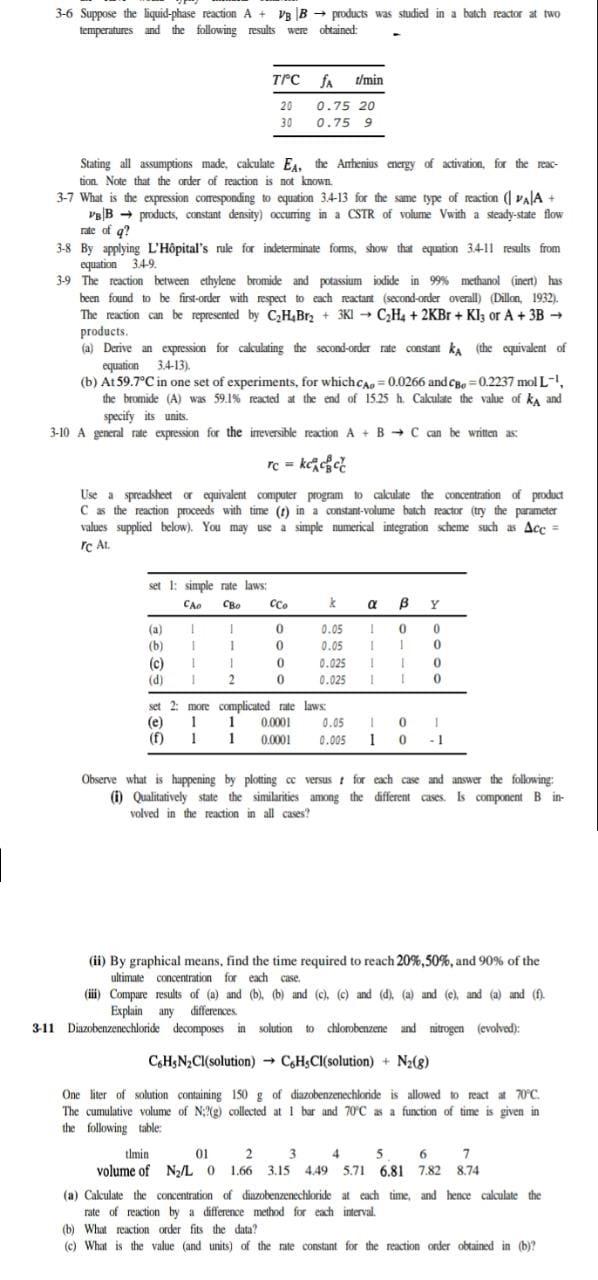Home /
Expert Answers /
Nursing /
answer-only-if-you-can-attempt-all-the-parts-3-6-suppose-the-liquid-phase-reaction-a-vg-b-prod-pa853
(Solved): ANSWER ONLY IF YOU CAN ATTEMPT ALL THE PARTS 3-6 Suppose the liquid-phase reaction A + vg B - prod ...
ANSWER ONLY IF YOU CAN ATTEMPT ALL THE PARTS
3-6 Suppose the liquid-phase reaction A + vg B - products was studied in a batch reactor at two temperatures and the following results were obtained: Trc ft/min 20 0.75 20 30 0.75 9 Stating all assumptions made, cakulate Ea, the Anhenius eiergy of activation, for the reac- tion. Note that the order of reaction is not known 3-7 What is the expression corresponding to equation 3.4-13 for the same type of reaction (AA+ vg|B ? products, constant density) occurring in a CSTR of volume Vwith a steady-state flow rate of q? 3-8 By applying L'Hôpital's rule for indeterminate forms, show that equation 3.4-11 results from equation 34-9. 3-9 The reaction between ethylene bromide and potassium iodide in 99% methanol inert) has been found to be first-order with respect to each reactant (second-order overall (Dillon, 1932). The reaction can be represented by C2H4Br2 + 3KICH. + 2KBr + Klz or A + 3B ? products (a) Derive an expression for calculating the second-order rate constant ka (the equivalent of equation 3.4-13). (b) At 59.7°C in one set of experiments, for which cao = 0.0266 and CB=0.2237 mol L !, the bromide (A) was 59.1% reacted at the end of 15.25 h. Calculate the value of kA and specify its units. 3-10 A general rate expression for the irreversible reaction A + B - C can be written as Tc = keho Use a spreadsheet or equivalent computer program to calculate the concentration of product C as the reaction proceeds with time (t) in a constant-volume batch reactor (try the parameter values supplied below). You may use a simple numerical integration scheme such as Acc = rc Al Set 1: simple rate laws: CAO CBO CCO a B Y (a) (b) b (c) c (d) (d 1 1 1 1 1 1 2 0 0 0 0 0.05 0.05 0.025 0.025 1 1 1 1 1 0 1 1 0 0 0 0 0 1 set 2: more complicated rate laws (e) (e) 1 0.0001 0.05 1 0 1 (f) 1 1 0.0001 0.005 10-1 Observe what is happening by plotting cc versus for each case and answer the following: (i) Qualitatively state the similarities among the different cases. Is component Bin- volved in the reaction in all cases! (ii) By graphical means, find the time required to reach 20%,50%, and 90% of the ultimate concentration for each case, (iii) Compure results of (a) and (b), (b) and (c), (c) and (d), (a) and (c) and (a) and (f) Explain any differences 3-11 Diazobenzenechloride decomposes in solution to chlombenzene and nitrogen (evolved): C.H N,Cl(solution) ? C.H.Cl(solution) + N2(8) One liter of solution containing 150g of diazobenzenechloride is allowed to react at 70°C. The cumulative volume of N:Ng) collected at 1 bar and 70'C as a function of time is given in the following table: tlmin 01 2 3 4 5 6 7 volume of N /L 0 1.66 3.15 4.495.71 6.81 7.82 8.74 (a) Calculate the concentration of dizobenzenechloride at each time, and hence calculate the rate of reaction by a difference method for each interval (b) What reaction order fits the data? (c) What is the value (and units) of the rate constant for the reaction order obtained in (b)?
